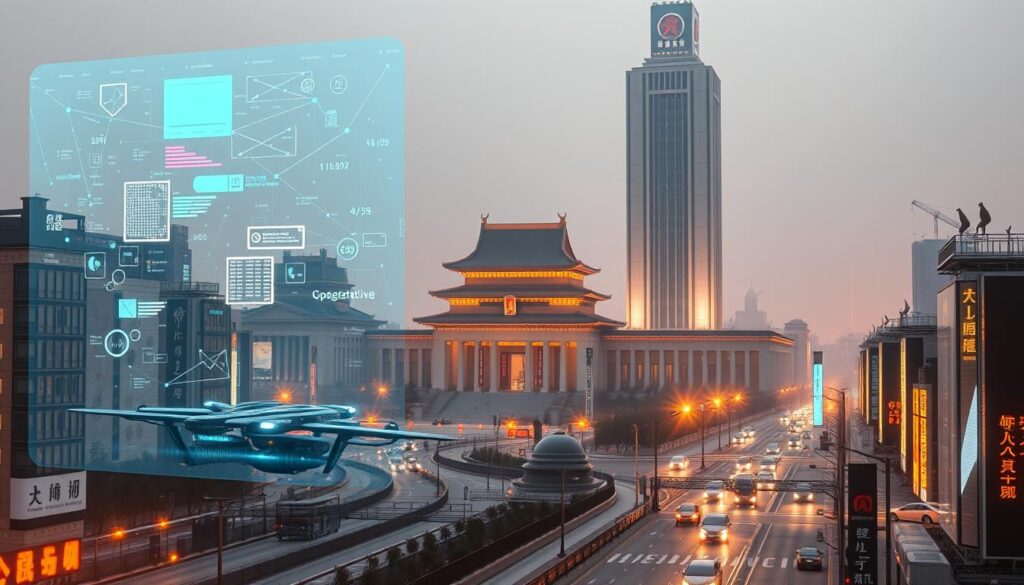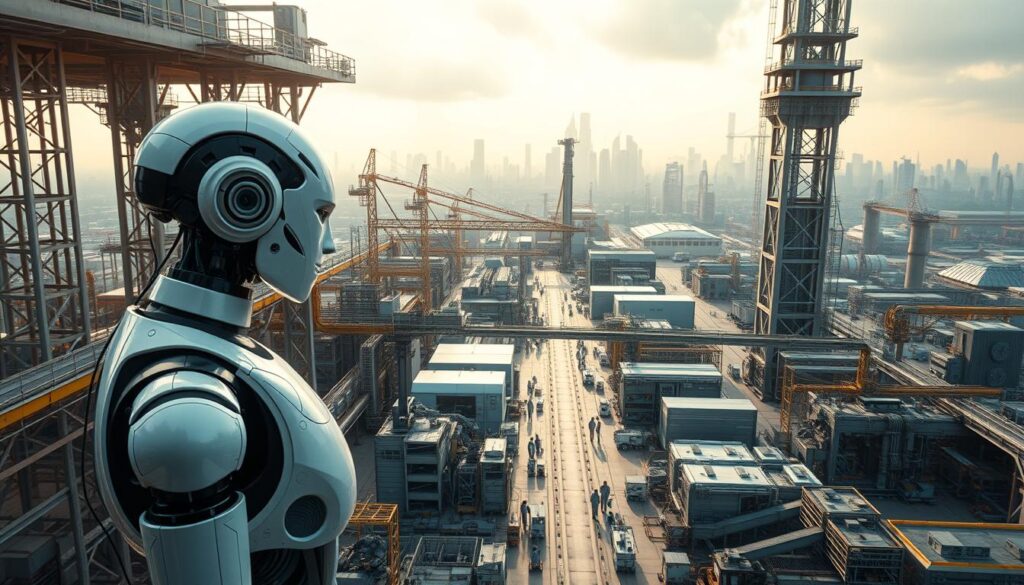“The future belongs to those who embrace innovation,” said Steve Jobs. This sentiment rings true as China emerges as a global leader in artificial intelligence, driving groundbreaking advancements that are reshaping industries worldwide.
China’s innovation ecosystem is thriving, fueled by a robust talent pool and strategic government support. With over 60 million users of the Talkie/Xingyue app and a vast internet user base, the country leverages massive datasets to refine its AI models1. Institutions like Tsinghua University are at the forefront, developing cutting-edge technologies that rival global competitors.
Breakthroughs like DeepSeek’s R1 model, which matches OpenAI’s ChatGPT in performance, highlight China’s growing prowess2. Despite challenges like US semiconductor sanctions, Chinese firms demonstrate resilience, optimizing resources to maintain momentum3.
This article explores how China’s strategic goals and technological power are closing global performance gaps, setting the stage for a new era of innovation.
Key Takeaways
- China boasts one of the largest AI talent pools globally, driving rapid innovation.
- Breakthrough models like DeepSeek’s R1 showcase competitive capabilities.
- Government funding and infrastructure support ensure stable AI growth.
- China’s vast datasets accelerate AI model training and refinement.
- Strategic goals focus on efficiency and resource optimization.
Introduction to China’s AI Revolution

The global artificial intelligence landscape is rapidly evolving, with China emerging as a formidable contender in this transformative field. While the United States has long been a leader in AI research, China’s strategic focus and massive investments are reshaping the global dynamics4.
Global Context and Emerging Trends
Artificial intelligence is no longer confined to a single country or region. The United States continues to dominate in terms of the number of AI companies and venture capital investments4. However, China’s rapid advancements in language models and generative AI are closing the gap5.
Emerging trends highlight the importance of large datasets and computational power. China’s annual data volume is growing at a compound annual growth rate of 26%, positioning it as a key player in AI development5.
China’s Strategic Vision in AI
China’s government has set ambitious goals to become a global AI powerhouse by 2030. With over $60 billion invested in AI development by 2020, the country is focusing on self-reliance and innovation6.
Academic institutions and private sector initiatives are working hand-in-hand to drive breakthroughs. For example, Alibaba’s Qwen 1.5 model, with 72 billion parameters, is a testament to China’s growing capabilities5.
| Metric | United States | China |
|---|---|---|
| AI Companies | 9,500 | 1,944 |
| Venture Capital Investments (2023) | $55 billion | $20 billion |
| Government AI Investment (2020) | N/A | $60 billion |
China’s strategic vision extends beyond domestic growth. The government aims to introduce over 50 new national and industry standards for AI by 2024, influencing at least 1,000 technology companies5. This approach ensures a cohesive and scalable AI ecosystem.
For more insights into the latest AI tools and trends, explore this comprehensive guide.
China’s AI Research and Development Landscape

China’s commitment to advancing artificial intelligence is evident in its robust research and development initiatives. The country’s strategic focus on innovation has led to groundbreaking methodologies and significant contributions from academic institutions.
Research Breakthroughs and Methodologies
Breakthroughs in China’s AI sector are driven by advanced methodologies and cutting-edge technologies. High-performance chip development plays a critical role in enhancing computing power, enabling faster and more efficient model training7.
For instance, Huawei Cloud’s Ascend service reduced large model training time from five months to just one month, showcasing the impact of optimized computing resources8. These advancements are tightly integrated into leading labs, fostering a culture of innovation.
Tsinghua University and Academic Contributions
Academic institutions like Tsinghua University are at the forefront of nurturing talent and driving innovation. Their research focuses on areas like generative AI and large language models, contributing to China’s growing capabilities9.
Collaborations between academia and industry ensure that research findings are quickly applied to real-world challenges. This synergy accelerates development and strengthens China’s position in the global AI landscape.
| Institution | Key Contribution | Impact |
|---|---|---|
| Tsinghua University | Generative AI Research | Advancing large language models |
| Huawei Cloud | Ascend Service | Reduced model training time |
| Baidu | ERNIE Bot | 11.5% market share in generative AI |
China’s R&D landscape is a testament to its strategic vision and resource optimization. By leveraging superior chip technology and fostering talent, the country is building a robust foundation for future innovations.
Government Policies Shaping China’s AI Future

China’s strategic policies are driving its leadership in artificial intelligence, shaping a future of innovation and self-reliance. The government plays a pivotal role in directing resources and creating a supportive ecosystem for technological advancements.
State-Directed Funding Mechanisms
The Chinese government has prioritized AI development through substantial funding. Plans to increase the fiscal deficit ratio to between 3.5% and 4% by 2025 highlight its commitment to long-term growth10. Subsidies of up to RMB 10 million (approximately US$1.41 million) are available for projects like intelligent computing centers, fostering domestic innovation10.
These initiatives ensure that resources are allocated efficiently, enabling companies to focus on breakthroughs. By reducing dependency on foreign technology, China strengthens its position in the global AI race.
Export Controls and Regulatory Challenges
Export controls and regulatory measures are critical components of China’s strategy. The 2024 Foreign Investment Negative List restricts or prohibits foreign investment in 29 fields, protecting domestic industries10. Meanwhile, the Foreign Investment Encouraged Catalogue includes 1,700 items, encouraging collaboration in key areas10.
These policies balance innovation with security concerns, ensuring that China remains competitive internationally. However, strict export control measures also pose challenges for companies navigating regulatory landscapes.
- Government funding accelerates AI research and development.
- Export controls protect domestic industries while fostering self-reliance.
- Regulatory challenges highlight the need for adaptive strategies in a competitive market.
China’s policies not only drive innovation but also create a robust foundation for sustainable growth. By addressing challenges and leveraging opportunities, the country is poised to lead the next wave of AI advancements.
Significant AI Models and Breakthroughs

China’s advancements in artificial intelligence are reshaping global benchmarks, with notable models pushing the boundaries of innovation. Recent developments highlight the country’s growing capability to compete with leading U.S. technologies.
Performance Comparison: U.S. and Chinese Models
Benchmark tests reveal that Chinese large language models, once trailing behind, are now closing the performance gap. For instance, DeepSeek’s R1 model matches or surpasses OpenAI’s ChatGPT on multiple key benchmarks while operating at a fraction of the cost11.
DeepSeek’s smaller versions have also outperformed OpenAI’s o1-mini in specific areas, showcasing their efficiency11. Despite requiring up to four times more computing power for similar results, Chinese companies are optimizing resources to enhance their capability11.
| Model | Performance | Computing Power |
|---|---|---|
| DeepSeek R1 | Matches ChatGPT | Lower cost |
| OpenAI o1-mini | Outperformed by DeepSeek | Higher cost |
Trends in Large Language Models
China’s focus on large language models is driving unique applications across industries. Alibaba Cloud, for example, has released over 100 open-source models supporting 29 languages, enabling diverse use cases11.
Chinese firms are adopting innovative approaches to overcome resource constraints. DeepSeek’s team, composed of fewer than 140 individuals, leverages home-grown talent to achieve remarkable results12.
These trends are not only enhancing domestic capability but also influencing international markets. With 36% of global AI models originating from China, the country is solidifying its position as a leader in the field11.
Financial Landscape and Investment Trends

The financial landscape for artificial intelligence in China is marked by a unique blend of private and state-backed investments. While the U.S. leads in venture capital flows, China’s strategic approach focuses on leveraging both private and public funding to drive innovation13.
Venture Capital Dynamics and Private Investments
Private investments in China’s AI sector are growing, though they lag behind the U.S. In 2023, U.S. venture capital investments in AI reached $55 billion, compared to China’s $20 billion13. Despite this gap, Chinese firms are securing significant funding rounds, particularly in areas like autonomous driving and generative AI.
Export restrictions have influenced investment decisions, prompting firms to focus on domestic solutions. For example, Xiaomi’s entry into the EV market, with plans to ship 100,000 units in 2024, reflects this shift14.
State-Backed Financial Support Strategies
China’s government plays a pivotal role in AI development through state-backed funding. Over the past five years, the U.S. committed $12 billion to AI-related obligations, while China’s investments have been more substantial13. Subsidies and grants are directed toward projects like intelligent computing centers, fostering domestic innovation.
State support ensures stability in the face of global challenges. For instance, the first AI-generated drugs entering clinical trials in China highlight the sector’s resilience14.
| Metric | United States | China |
|---|---|---|
| Venture Capital (2023) | $55 billion | $20 billion |
| Government AI Investment (2020-2025) | $12 billion | $60 billion |
| Key Focus Areas | Generative AI, Robotics | Autonomous Driving, Healthcare |
These financial dynamics are reshaping the competitive landscape, with China’s focus on self-reliance and innovation driving long-term growth. For more insights into how AI is transforming finance, explore AI in finance.
Leveraging China’s Technological and Manufacturing Ecosystem

China’s technological and manufacturing ecosystem is a cornerstone of its AI advancements. The integration of cutting-edge technology with its advanced manufacturing capabilities has created a robust foundation for innovation. This synergy is particularly evident in the semiconductor industry, which plays a pivotal role in supporting AI initiatives15.
The semiconductor ecosystem in China has grown significantly, driven by both domestic demand and strategic investments. For instance, Huawei’s Ascend 9XX series chips have seen demand exceeding one million units, showcasing the industry’s capacity to meet high-performance computing needs16. This growth is further supported by government policies aimed at strengthening research and development of key products like GPUs15.
Collaborative partnerships within the ecosystem are another critical factor. The National Integrated Supercomputing Power Scheduling Platform, launched in 2023, exemplifies how resource availability and strategic alliances drive competitive advantage15. Such initiatives ensure that computing power is as readily available as electricity, enabling seamless AI development15.
Manufacturing success stories also highlight China’s ability to scale production efficiently. For example, Alibaba’s Qwen model is being used by 90,000 enterprises across various sectors, demonstrating the practical applications of AI innovations16. This industrial-scale production not only bolsters AI advancements but also ensures long-term growth through effective resource allocation15.
| Initiative | Impact |
|---|---|
| National Integrated Supercomputing Power Scheduling Platform | Enhanced computing power availability |
| Huawei Ascend 9XX Series Chips | High-performance computing solutions |
| Alibaba Qwen Model | Wide enterprise adoption across sectors |
The interplay between industrial production and technological advancement is a key driver of China’s AI success. By leveraging its mature manufacturing base and robust semiconductor ecosystem, the country is well-positioned to sustain its leadership in AI innovation. For more insights into how technology is transforming industries, explore this comprehensive guide.
Top Chinese AI Start-Ups Driving Innovation

Innovative start-ups in China are redefining the global tech landscape with groundbreaking advancements. These companies are not only transforming industries but also setting new standards for artificial intelligence development. Leading the charge are firms like Zhipu AI, which has become a key player in the competitive AI market17.
Zhipu AI and Market Impact
Zhipu AI, valued at over $2 billion, is planning an IPO soon, reflecting its growing influence17. Its GLM-4-Plus model matches the performance of GPT-4, utilizing high-quality synthetic data to reduce training costs17. This approach has allowed the company to scale efficiently while maintaining competitive edge.
Another notable company, Infinigence AI, has attracted $140 million in funding. Its HetHub system aims to optimize AI training time by 30%, showcasing the firm’s commitment to innovation17.
Collaboration within the Tsinghua Ecosystem
Collaborations within the Tsinghua University network are fostering rapid innovation. Start-ups like Zhipu AI benefit from academic partnerships, which accelerate research and development17. These alliances ensure that cutting-edge technologies are quickly commercialized.
Government initiatives also play a crucial role. The New Generation AI Development Plan aims to build a domestic AI industry worth over 1 trillion yuan by 203018. This support enables Chinese firms to focus on long-term growth and global competitiveness.
| Company | Key Achievement | Impact |
|---|---|---|
| Zhipu AI | GLM-4-Plus matches GPT-4 | Reduced training costs |
| Infinigence AI | HetHub system | 30% faster training |
| Moonshot AI | Kimi Chat supports 200,000 characters | Enhanced user experience |
These developments highlight the strategic collaboration between academia, industry, and policymakers. By leveraging their combined strengths, Chinese start-ups are driving innovation and shaping the future of AI.
Closing the Performance Gap in Global AI

Recent benchmark tests highlight the narrowing performance gap between Chinese and U.S. AI technologies. Over the past year, Chinese large language models (LLMs) have made significant strides, catching up to their U.S. counterparts in various tasks and service areas19.
Benchmarking Chinese LLMs
Benchmark scores from tests like SuperCLUE reveal that Chinese models are now competitive with U.S. technologies. For instance, DeepSeek’s R1 model matches OpenAI’s ChatGPT in key performance metrics, operating at a fraction of the cost19. This improvement is attributed to advancements in task-specific optimizations and efficient resource utilization.
Chinese models have also excelled in areas like natural language processing and image recognition. Alibaba’s Qwen 1.5 model, with 72 billion parameters, demonstrates superior performance in multilingual services20.
Comparative Analysis with U.S. Models
While U.S. models still lead in high-impact research, Chinese models are closing the gap in raw performance. Over the last year, Chinese LLMs have reduced training times and improved efficiency, leveraging massive datasets and strategic investments21.
For example, Huawei Cloud’s Ascend service cut large model training time from five months to just one month, showcasing China’s ability to optimize computing resources19. This progress is critical in narrowing the global AI performance gap.
| Model | Performance | Key Strength |
|---|---|---|
| DeepSeek R1 | Matches ChatGPT | Cost efficiency |
| Alibaba Qwen 1.5 | Multilingual services | Scalability |
| Huawei Ascend | Reduced training time | Resource optimization |
These advancements have broader implications for global AI competitiveness. As Chinese models continue to improve, they challenge U.S. dominance in the field, driving innovation and efficiency worldwide20.
Integrating AI Across Industrial Sectors

Artificial intelligence is revolutionizing industries across China, with state-driven initiatives and emerging technologies reshaping production and operational models. From manufacturing to healthcare, AI is becoming a critical part of modern industrial strategies22.
In manufacturing, AI-powered systems optimize production lines, reducing waste and improving efficiency. For example, smart factories use machine learning to predict equipment failures, minimizing downtime4. This integration of intelligence into operations is transforming traditional workflows.
The state plays a pivotal role in driving this transformation. China’s AI Plus initiative, introduced in the 2024 government work report, aims to integrate AI across various industries in the real economy22. This initiative supports the development of emerging technologies that enhance productivity and innovation.
Healthcare is another sector benefiting from AI integration. Advanced algorithms analyze medical data to improve diagnosis accuracy and treatment plans. For instance, AI-driven systems are being used to detect early signs of diseases, improving patient outcomes4.
Operational efficiency is a key focus. AI systems streamline supply chains, ensuring timely delivery of goods. Companies like Alibaba use AI to manage inventory and logistics, reducing costs and improving customer satisfaction22.
Real-world applications highlight the impact of AI. In agriculture, drones equipped with AI monitor crop health, optimizing irrigation and fertilization. This use of emerging technologies ensures sustainable farming practices4.
| Sector | AI Application | Impact |
|---|---|---|
| Manufacturing | Predictive Maintenance | Reduced Downtime |
| Healthcare | Diagnosis Systems | Improved Accuracy |
| Agriculture | Drone Monitoring | Sustainable Practices |
These integrations influence industrial strategies, driving long-term growth. By leveraging AI, industries can adapt to changing demands and remain competitive in a global market22. The state’s support ensures that these advancements are sustainable and scalable.
In conclusion, AI is a transformative force across multiple sectors. With state initiatives and emerging technologies, China is leading the way in integrating intelligence into industrial processes, setting a benchmark for the future4.
AI in Emerging Technologies and Future Roles

Emerging technologies are reshaping industries, with robotics and biotechnology leading the charge. These fields are becoming a priority for innovation, driven by advancements in artificial intelligence. From intelligent automation to groundbreaking biotech applications, AI is transforming how we approach complex challenges.
Applications in Robotics and Automation
Robotics is one of the most dynamic areas where AI is making a significant impact. Intelligent automation systems are optimizing manufacturing processes, reducing costs, and improving efficiency. For example, AI-powered robots can now perform intricate tasks with precision, minimizing human error23.
Deploying AI at the edge enables faster response times and greater data privacy, which is critical for industries like logistics and healthcare24. These innovations are not only enhancing productivity but also creating new opportunities for growth.
Innovations in Biotechnology
Biotechnology is another strategy where AI is driving transformative change. Advanced language models are being used to analyze complex biological data, accelerating drug discovery and personalized medicine23. For instance, AI algorithms can predict protein structures, reducing the time required for research and development.
China’s investment in generative AI is projected to surge, with an estimated 86% CAGR over the next five years24. This growth is fueling innovations that address global health challenges, such as early disease detection and treatment optimization.
As AI continues to evolve, its integration with other emerging technologies will unlock new possibilities. For more insights into how AI is revolutionizing industries, explore this comprehensive guide.
Overcoming Resource and Export Control Challenges
![]()
Resource constraints and export control measures are reshaping China’s approach to technological innovation. With access to advanced semiconductor technologies restricted, Chinese companies are adapting to maintain progress in artificial intelligence development25.
Domestic Semiconductor Development
China is investing heavily in domestic semiconductor production to reduce reliance on foreign technology. Companies like Huawei are developing high-performance chips, such as the Ascend 9XX series, to meet growing demand25. This focus on self-reliance is critical in overcoming export barriers.
Government initiatives, including subsidies for intelligent computing centers, further support this effort. These measures ensure that access to critical components remains stable, even under restrictive policies25.
Innovative Workarounds for Compute Limitations
Chinese firms are adopting creative strategies to address compute limitations. For example, smaller cloud providers offer server rentals at competitive rates, making access to computing power more affordable25. Larger operators like Alibaba provide advanced services, bridging the gap caused by export controls.
Black market activity for Nvidia hardware has surged, highlighting the demand for high-performance chips25. Despite these challenges, companies are optimizing resources to sustain innovation.
| Service Provider | Cost per Hour | Key Feature |
|---|---|---|
| Smaller Chinese Cloud Providers | $6 | Affordable access |
| Alibaba Cloud | $12-$18 | Advanced services |
| US Vendors | $10-$32 | Higher cost |
These strategies demonstrate China’s resilience in the face of export restrictions. By leveraging domestic production and innovative solutions, the country continues to advance its AI capabilities25.
For more insights into how export controls are shaping global technology, explore this analysis.
Future Prospects for China’s AI Ecosystem

China’s AI ecosystem is poised for transformative growth, driven by strategic investments and cutting-edge advancements. With sustained funding and a focus on innovation, the country is set to redefine global technological landscapes.
Predicted Technological Advancements
China’s government aims to build a 1 trillion yuan AI-powered economy by 2030, signaling its commitment to long-term growth26. This ambitious goal is supported by significant investments, such as the Bank of China’s pledge of 1 trillion yuan over the next five years to strengthen the AI supply chain26.
Emerging technologies like robotics and biotechnology are expected to drive innovation. For instance, China deployed nearly 300,000 industrial robots, far surpassing other nations3. This focus on automation will enhance productivity and efficiency across industries.
Long-Term Global Impact
China’s advancements are reshaping global markets, with ripple effects on international competitiveness. The Cyberspace Administration of China has approved over 180 large language models for general use, showcasing the country’s growing capabilities3.
Strategic investments in computing hubs and infrastructure, such as Beijing’s $6 billion initiative, ensure sustained progress26. These developments position China as a key player in the global AI race.
For more insights into how AI is transforming industries, explore this comprehensive guide.
What Are the Key AI Innovations Coming from China?

China’s advancements in technology are reshaping global dynamics, with a focus on innovation and strategic growth. From cutting-edge research to industrial applications, the country is setting new benchmarks in artificial intelligence.
Key breakthroughs include models like DeepSeek’s R1, which matches global competitors in performance while operating at lower costs27. These advancements are supported by a robust ecosystem of academic institutions, government policies, and private sector collaboration.
China’s leadership in AI is driven by its ability to leverage vast datasets and optimize resources. For instance, Huawei Cloud’s Ascend service reduced large model training time from five months to just one month4. This efficiency is critical in maintaining momentum despite external challenges.
The interconnectedness of research, policy, and industrial scale-up has been a cornerstone of China’s success. Government initiatives, such as the New Generation AI Development Plan, aim to build a domestic AI industry worth over 1 trillion yuan by 20304.
These innovations are not only transforming industries within China but also influencing global technology dynamics. As Chinese models continue to improve, they challenge U.S. dominance, driving innovation and efficiency worldwide1.
Reflecting on these advancements raises critical questions for U.S. policymakers. How can the U.S. maintain its competitive edge in the face of China’s rapid progress? The answer lies in strategic investments, enhanced collaboration, and a focus on long-term growth.
In summary, China’s strategic approach to AI development is reshaping the global landscape. By fostering innovation and leveraging its unique strengths, the country is poised to lead the next wave of technological advancements.
Strategies for U.S. Competitive Response
The U.S. must adopt strategic measures to counter China’s rapid advancements in technology. With export controls expanding and global competition intensifying, a cohesive approach is essential to maintain leadership in artificial intelligence.
Policy Recommendations and National Data Strategy
A coherent national data strategy is critical for supporting AI research and deployment. The U.S. should streamline permitting processes and provide access to affordable energy to attract data centers28. This ensures the country remains a hub for innovation.
Policy adjustments must address export controls and resource allocation. For instance, the U.S. export control regime includes four types of controls: list-based, end-user, end-use, and services controls29. These measures safeguard critical technologies while fostering growth.
Enhancing Investment and Strategic Collaboration
Both private and governmental investment in AI must be prioritized. The U.S. Commerce Control List (CCL) includes dual-use items described by Export Control Classification Numbers (ECCNs), ensuring strategic oversight29. This framework supports innovation while protecting national interests.
Collaboration with allies is equally important. The U.S. export control strategy relies on the cooperation of nations, though many lack equivalent authorities to tools like the FDPR and Entity List29. Strengthening these partnerships is vital for global competitiveness.
Actionable steps include aligning investments with national security and economic priorities. The U.S. must also ensure it remains the most attractive place for data centers by addressing energy and regulatory challenges28.
| Strategy | Key Action | Impact |
|---|---|---|
| National Data Strategy | Streamline permitting and energy access | Attract data centers |
| Export Controls | Implement list-based and end-use controls | Safeguard critical technologies |
| Investment | Prioritize private and governmental funding | Drive innovation |
By adopting these strategies, the U.S. can respond effectively to China’s rapidly evolving ecosystem. A comprehensive approach ensures long-term growth and global leadership in artificial intelligence.
Collaboration vs. Competition in Global AI Markets
The interplay between collaboration and competition is shaping the future of global artificial intelligence markets. While nations vie for leadership, cross-border partnerships are driving mutual advancements, creating a complex dynamic that influences innovation and policy.
China and the U.S. have co-authored 47,715 AI research articles, showcasing the potential of international cooperation30. These collaborative efforts often result in higher-quality research compared to partnerships with other countries30. However, geopolitical tensions and regulatory barriers, such as the proposed Stop CCP VISAs Act, threaten to disrupt this synergy30.
Despite these challenges, strategic partnerships remain crucial. For instance, Baidu’s Ernie 4.5 and Tencent’s Hunyuan 3D-2.0 demonstrate how shared expertise can lead to groundbreaking advancements in multimodal understanding and AI-generated content30. Such innovations highlight the benefits of pooling resources and knowledge across borders.
On the other hand, competition drives rapid progress. The U.S. and China are locked in a multifaceted rivalry, with both nations investing heavily in talent, infrastructure, and regulatory frameworks30. This competition fosters innovation but also raises concerns about resource allocation and market dominance.
For U.S. policymakers, balancing collaboration and competition is critical. Streamlining permitting processes for data centers and enhancing international partnerships can ensure sustained growth30. A coherent national data strategy is essential to maintain leadership in the global AI race.
In conclusion, the future of AI depends on finding the right balance. While competition fuels progress, collaboration ensures that advancements benefit humanity as a whole. Strategic engagement will be key to shaping a sustainable and inclusive global AI ecosystem.
Conclusion
The rapid evolution of technology continues to redefine global competitiveness, with China’s advancements playing a pivotal role. From breakthroughs in large language models to strategic investments in infrastructure, the country is reshaping the technological landscape. Models like DeepSeek-R1 deliver performance comparable to GPT models at just 3% of the cost, showcasing efficiency and innovation31.
For U.S. policymakers, these developments present both challenges and opportunities. Addressing resource constraints and fostering collaboration will be critical to maintaining a competitive edge. Strategic investments in research and infrastructure, such as those outlined in the CHIPS and Science Act, are essential steps forward32.
Looking ahead, the future of technology will depend on adaptability and innovation. As China continues to push boundaries, global stakeholders must prioritize dialogue and research to navigate this dynamic field. Explore emerging tools to stay ahead in this evolving landscape.
FAQ
How is China advancing in artificial intelligence research?
What role does the Chinese government play in AI development?
How do Chinese AI models compare to those from the U.S.?
What are the key challenges China faces in AI development?
How is China integrating AI across industries?
What is the future of China’s AI ecosystem?
How does China’s AI strategy impact global markets?
What are the financial trends supporting China’s AI sector?
Source Links
- China’s AI Boom: Talent and Innovation Driving the Future – RisCura
- China’s DeepSeek and its Open-Source AI Models
- Assessing China’s AI development and forecasting its future tech priorities
- How Innovative Is China in AI?
- China’s AI-Powered Industrial Revolution: Transforming Manufacturing and Beyond!
- China’s AI Policy & Development: What You Need to Know
- China And AI In 2025: What Global Executives Must Know To Stay Ahead
- An Analysis of China’s AI Governance Proposals | Center for Security and Emerging Technology
- China’s Policy-Driven Initiatives Shaping Its Industries in 2025
- How a top Chinese AI model overcame US sanctions
- DeepSeek: How China’s ‘AI heroes’ overcame US curbs to stun Silicon Valley
- Stakes Rising In The US-China AI Race
- How AI is shaping industries in China | J.P. Morgan Research
- China’s AI development model in an era of technological deglobalization
- China’s Generative AI Ecosystem in 2024: Rising Investment and Expectations
- Four Chinese AI startups to watch beyond DeepSeek
- Top Companies, Innovations & ChatGPT Rivals
- The AI Superpower Showdown
- China in the Global AI Race: Strengths, Challenges, and the Road Ahead
- The AI Diffusion Framework: Securing U.S. AI Leadership While Preempting Strategic Drift
- In Developing AI, China Takes the Industrial Route
- China’s AI future in a quest for geopolitical, computing and electric power
- The Future Of Technology: Generative AI In China
- The Impact Of US Export Regulations On Nvidia AI Chips To China
- Beyond DeepSeek: How China’s AI Ecosystem Fuels Breakthroughs
- China Is Rapidly Becoming a Leading Innovator in Advanced Industries
- America’s AI Strategy: Playing Defense While China Plays to Win
- Understanding U.S. Allies’ Current Legal Authority to Implement AI and Semiconductor Export Controls
- The AI Superpower Rivalry: A Zero-sum Game Between China and the United States?
- Beyond DeepSeek: An Overview of Chinese AI Tigers and Their Cutting-Edge Innovations
- China’s AI Ambitions: Innovation, Ethics, and Global Competition







